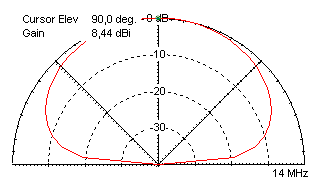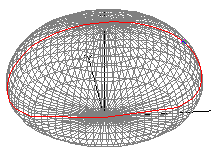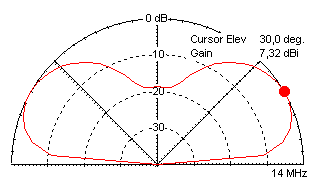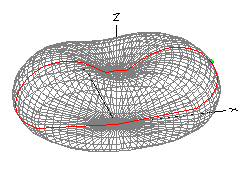A simple TRAP-dipole for 20 and 40m bands
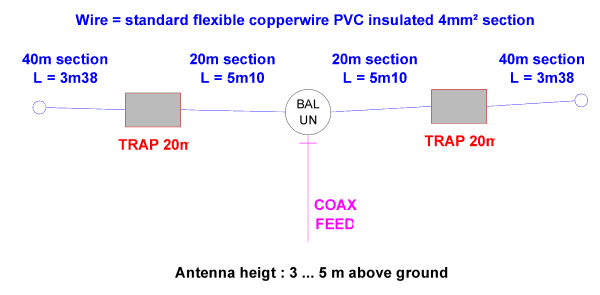
- Performance on 20m is moderate,
this is due to low elevation of antenna. By experience, I have noticed that
a 20m band dipole antenna must be elevated by at least 8m above ground to
perform well ! There are at least to 2 or 3 S-points difference between a
20m dipole elevated at 3m and 8m ! See the EZNEC simulations below.
- Performance on 40m is very good.
A 40m dipole at this height becomes omni directional, so do not worry about
the orientation of the dipole vs. 'homebase'. You will be amazed by
the results obtained, both for continental contacts and real DX ! I worked
several ZL with this antenna only 3m high in SSB with 100w ...
- A dipole has a nominal impedance of
73 Ohm, but at this height this will drop to 50 Ohm. No problems to operate
over the full 20 and 40m with SWR < 1.5, so you will not need a
tuner, if you adjust the antenna well.
- Construction of traps :
see my page on the site
- A balun is not a 'must' but
recommended ...
- How to adjust the antenna ? Cut all
wires + 20 cm too long and assemble the antenna, completely with traps.
First adjust the 20m section, cut both ends carefully till resonance
on centre of band. Then adjust the 40m section by cutting tail ends till
best SWR at band centre.
- Dipole wire lengths : I made several
different dipoles and observed for 20m section 5m07 to 5m10, for 40m section
3m40 to 3m38, but total is 8m47. Length can vary according to
elevation, ground conductivity, presence of surrounding objects (trees,
house, ...)
- If the dipole is mounted as
inverted-V with apex height @ 6m on a fiberglass pole, I observed lengths of
20m section of 5m20 and for 40m 3m25 (total = again about 8m45, wire
section 4mm²) I used this antenna in the IOTA contest in 2007
activating EU-105 with good results (
see picture ).
The 'EU39' : a high performance inverted V for 15, 20, 40 and 80m
bands
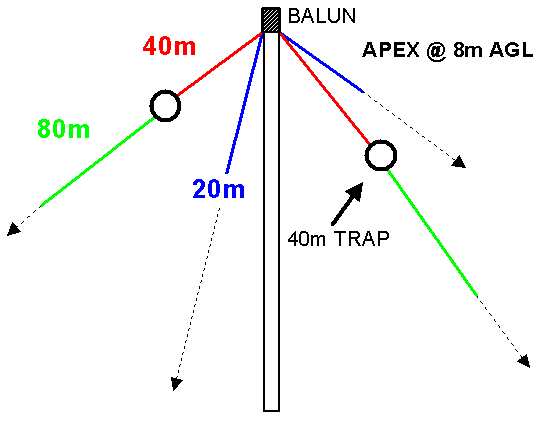
The idea was to make a high performance inverted-V for field day or holidays.
'High performance' means full sized elements on 20 and 40m, the best bands for
DX and continental QSO's, and for 80m the antenna is shortened. This
antenna has been used several times for IOTA activations.
- The inverted-V is supported by a telescopic fiberglass pole (e.g.
Spiderbeam 12 or 18m.), the apex can be at 8m - but optimal
height (for 20m radiation) is at 12 to 13m. Don't forget to secure each
element with adhesive tape (very temporary setup, not safe !) or adjustable
circular clamps (with rubber protection).
- The 4 sections are mounted at 90° angles with respect to each other and
provide guying for the pole.
- The feed is with a current balun.
- The 20m and 40/80m sections are simply fed in parallel, this does not
deteriorate performances.
- The 40m section will as well resonate on 15m, on the 'high end' of the
band. SWR is decent over the entire 15m and can be easily matched with
transceiver built-in ATU, or matched by the PA finals, while the antenna is
efficient.
- Lengths :
- 20m section:
5m05 wire 4mm² section
- 40m section:
10m20 wire 4mm² section (see remark)
- 80m tail end section: 5m20
wire 2.5mm² section (total length= 15m40. Use about 2 or 3m more of strong
rope to secure to small pickets, so the tail is about 1m off the ground
surface) (see remark)
- Performance on 15m, 20m and is 40m is excellent. Bandwidth
is very broad on 20 and 40m, for 80m at least 100 kHz for SWR <1.5. For SSB
and CW operation on 80m, cut the antenna for SSB and make 2 small 'tails'
that can be added with banana plugs at the end of both legs.
Remark regarding the wire diameter: I observed that, using a wire of
dia 1.5mm² section, the length is longer than 4mm². For inveted-V 40/80m with
apex 8m AGL, the 40m section will be 10m72, the 80m section 5m00.
Some EZNEC antenna simulations



